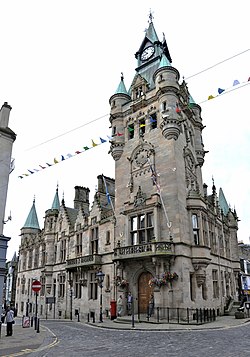| Dunfermline City Chambers | |
|---|---|
 Dunfermline City Chambers Dunfermline City Chambers | |
| Location | 3 Bridge Street, Dunfermline |
| Coordinates | 56°04′15″N 3°27′50″W / 56.0708°N 3.4640°W / 56.0708; -3.4640 |
| Built | 1879 |
| Architect | James Campbell Walker |
| Architectural style(s) | French Gothic style |
| Listed Building – Category A | |
| Designated | 12 January 1971 |
| Reference no. | LB25973 |
 | |
Dunfermline City Chambers is a municipal facility at the corner of Bridge Street and Kirkgate in Dunfermline, Fife. The building, which serves as home to the local area committee of Fife Council, is a Category A listed building.
History
The building was commissioned to replace the old town house in Bridge Street which had been completed in 1771. After rapid industrial growth in the local area, civic leaders decided they needed a more substantial facility and the old town house was demolished, to make way for the current building.
The foundation stone for the new building was laid on 11 October 1876. It was designed by James Campbell Walker in the French Gothic style, built by Messrs W & J Hutchison and completed in May 1879. The design involved an asymmetrical main frontage with twelve bays facing onto Kirkgate; the southern section featured a doorway with an octagonal turret above in the south east corner, while the northern section featured an elaborate doorway with a balcony and prominent four-face clock tower with bartizans in the north east corner. The structure included heraldic stones, recovered from the demolished 18th century town house, which may have originated from the now derelict Dunfermline Palace, a few hundred yards to the south. The stonework on the Bridge Street façade included busts of Malcolm Canmore, Queen Margaret, Robert the Bruce and Elizabeth de Burgh. Internally, the principal room was the council chamber on the first floor: it incorporated an oak hammerbeam roof. There were police cells in the basement of the building.
The building was the headquarters of the royal burgh of Dunfermline until it was replaced by Dunfermline District under the wider Fife Regional Council in May 1975. The building ceased to be a seat of government after the district council was abolished in 1996, under the Local Government etc. (Scotland) Act 1994. Since then, the building has served as the home of the local area committee of Fife Council, as a venue for marriages and civil partnerships and as the local registration office.
Works of art in the city chambers include Sir Joseph Paton's painting of Queen Margaret and Malcolm Canmore.
See also
- List of Category A listed buildings in Fife
- List of listed buildings in Dunfermline, Fife
- Edinburgh City Chambers
- Glasgow City Chambers
References
- ^ Historic Environment Scotland. "3 Bridge Street, City Chambers (Category A Listed Building) (LB25973)". Retrieved 13 April 2020.
- ^ "History of Bridge Street" (PDF). Royal Dunfermline. pp. 13–18. Retrieved 13 April 2020.
- Simpson, Eric (1987). The Auld Grey Toun – Dunfermline in the time of Andrew Carnegie 1835–1919. Carnegie Dunfermline Trust. p. 85. ISBN 978-0947559090.
- Beattie, George. "James Stewart & Sons, Builders & Quarrymasters". Dunfermline Historical Society. Retrieved 13 April 2020.
- "Ten town halls to visit". The Telegraph. 29 November 2008. Retrieved 13 April 2020.
- ^ "Dunfermline Guide Book" (PDF). p. 34.
- "Local Government (Scotland) Act 1973". Legislation.gov.uk. Retrieved 16 April 2020.
- McEwan Bert Dunfermline: The Post-War Years p.16.
- "Local Government etc (Scotland) Act 1994". Legislation.co.uk. Retrieved 13 April 2020.
- "Baby Jamie snoozes through his first council meeting". The Courier. 8 September 2016. Retrieved 14 April 2020.
- "Weddings in Fife" (PDF). Fife Council. p. 8. Retrieved 23 September 2020.
- "Dunfermline Customer Service Centre - City Chambers". Fife Council. Retrieved 23 September 2020.
- "The Patons of Dunfermline". Royal Scottish Academy. 26 June 2020. pp. 22–23. Retrieved 23 September 2020.
- Paton, Joseph Noel. "Queen Margaret and King Malcom Canmore". Art UK. Retrieved 23 September 2020.
Further reading
- McEwan, Bert (1998), Dunfermline: Our Heritage
- City chambers and town halls in Scotland
- Government buildings completed in 1879
- 1879 establishments in Scotland
- Buildings and structures in Dunfermline
- Category A listed buildings in Fife
- Listed government buildings in Scotland
- Politics of Dunfermline
- Clock towers in the United Kingdom
- Gothic Revival architecture in Scotland